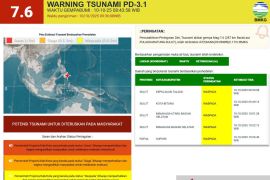The tsunami which was triggered by a powerful earthquake measuring 7.4 on the Richter scale hit the areas in Central Sulawesi in the early evening hour of Friday, September 28, 2018.
When the disaster struck, the local people probably assumed they were secured inside their concrete structure house buildings, but moments after the powerful earthquake at 6:02 p.m. Central Indonesia Standard Time, the nightmare waves, estimated to have been six-meter high, smashed into the shores of Palu and Donggala.
On that fateful morning of Friday, more than one thousand people stepped out of their beds little realizing that was to be their last day on this vale of tears.
However, death knows no age limit, no partiality. It is a thing that all people fear.
The potent tsunamis, the largest and rarest waves in all the seven seas, washed part of Palu and Donggala that Friday evening and killed more than 1,200 people.
As of Monday morning, temporary data showed that the devastating disaster had claimed some 1,203 lives.
Usually generated by violent disturbances of the earth`s crust, tsunamis are hard to predict and can be deadly.
How can a wave that barely ripples the surface in the open ocean rise to such devastating heights near the shore?
Scientists has said a tsunami`s energy is distributed throughout the water column, regardless of the ocean`s depth.
The widely spaced waves, which can be hundreds of mile apart, retain nearly all their energy even while traversing great distances.
As the ocean depth decrease nearer to land, the energy of the wave compresses into a smaller space, forcing the tsunami to gain height and slow to some 30 miles per hour.
Then the wave unleashed its deadly energy against the shores of Palu and Donggala in Central Sulawesi.
Of more than one thousand people killed by the earthquake and tsunami in these two areas of Central Sulawesi, most probably had no idea they were in mortal danger.
But it happened, and caused a deep sorrow for Indonesians after another massive earthquake hit Lombok island in West Nusa Tenggara Province and killed more than 560 people late of last July.
Now Indonesia is grieving again with the occurrence of tsunami and earthquake disaster in Central Sulawesi.
This unexpected natural disaster was very heartbreaking and caused deep sorrow and trauma for Indonesians.
Hence, President Joko Widodo (Jokowi) has called on his countrymen to pray for the victims of earthquake and tsunami in Palu and Donggala.
The President certainly believes that prayer is the answer to all problems of life.
For the prayer is the breath of the soul, the organ by which one can receive peace and comfort into his or her parched and withered heart.
No matter in what distress one may be, distress of body or of soul, he or she needs but look unto Him who is always near with that healing power which can immediately overcome the death-dealing poison and its terrible consequences both to body and soul.
Prayer is for the helpless victims of tsunami and earthquake in Palu and Donggala.
With this in mind, President Jokowi in the company of Central Java Governor Ganjar Pranowo and Central Java Police Chief Ins Gen Condro Kirono on Sunday morning, attended a mass prayers event in Solo, organized for the natural disasters` victims.
Following the prayers led by KH Al Munawar and participated in by several thousand people, Jokowi left for Palu to observe the condition in the capital of Central Sulawesi Province.
Arriving at the City of Palu on Sunday afternoon, the president immediately visited various locations and victims affected by the earthquake, including Undata Hospital where hundreds of victims were being treated.
On a notice board at the Special Disaster Management Command Post in the yard of the residence of the Central Sulawesi Governor Longki Djanggola, it stated that out of 668 deaths, 193 bodies were handled in Undata Hospital, 351 bodies in Bhayangkara Hospital, 50 bodies in the Great Mosque, 41 body in Balaroa National Park, 20 bodies in Pantoloan Parent, 11 bodies in Wirabuana Hospital, and two bodies in Kayu Malue Pajeko.
While the number of refugees has reached 31,230 people, 632 people were injured, 29 people were missing, 140 people were buried in ruins, and 65,713 units of houses were damaged.
The provisional data states that the number of victims is expected to continue to increase because officers from the relevant agencies continue to search and evacuate more victims.
The data is only from Palu City, not from the districts of Donggala, Sigi, and Parigi Muotong which were also hit by the earthquake and tsunami.
In addition, the announcement also stated that a number of buildings and infrastructure were damaged, such as the Yellow Bridge, Mutiara Airport, Roa Roa Hotel, Tatura Mall, De Syah Hotel, various roads in 12 locations, Anatapura Hospital, Talise Pavilion, and TVRI office building.
Editing by INE
Reporter: Otniel Tamindael
Editor: Otniel Tamindael
Copyright © ANTARA 2018












